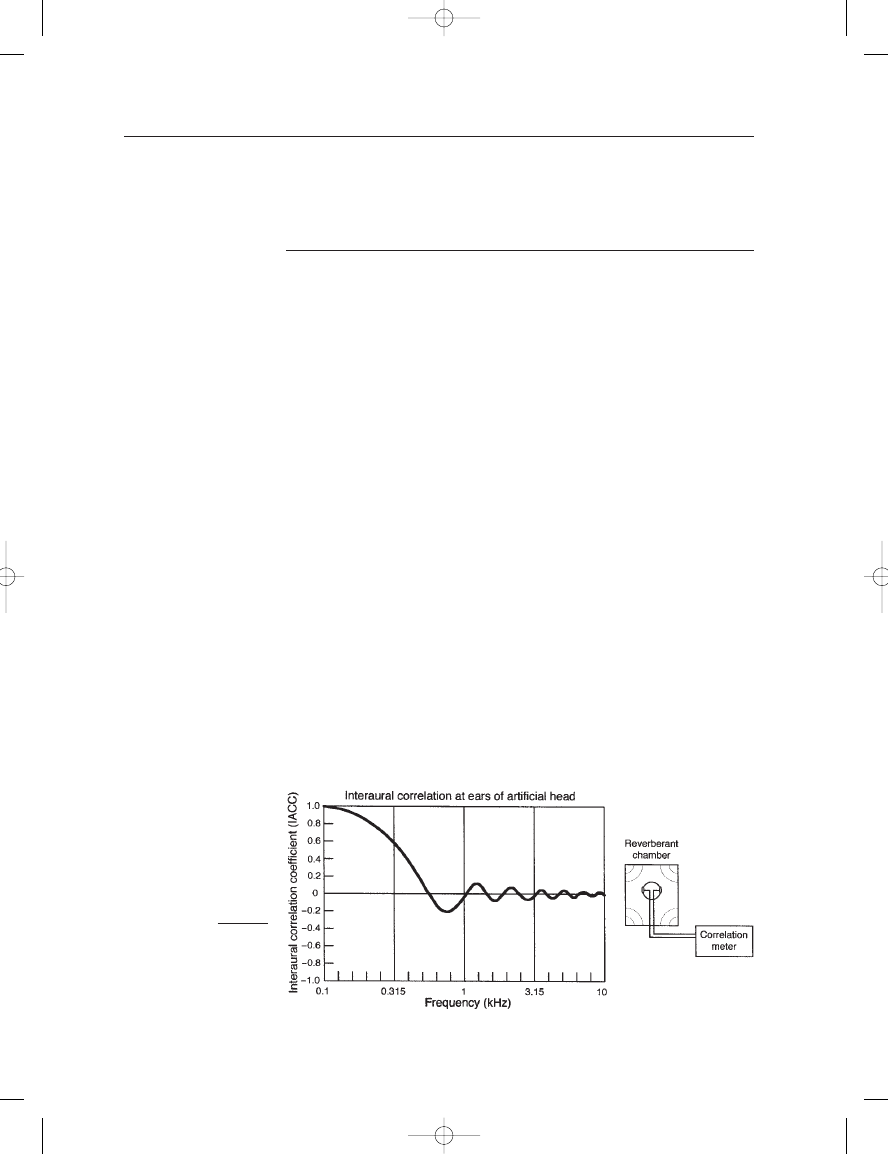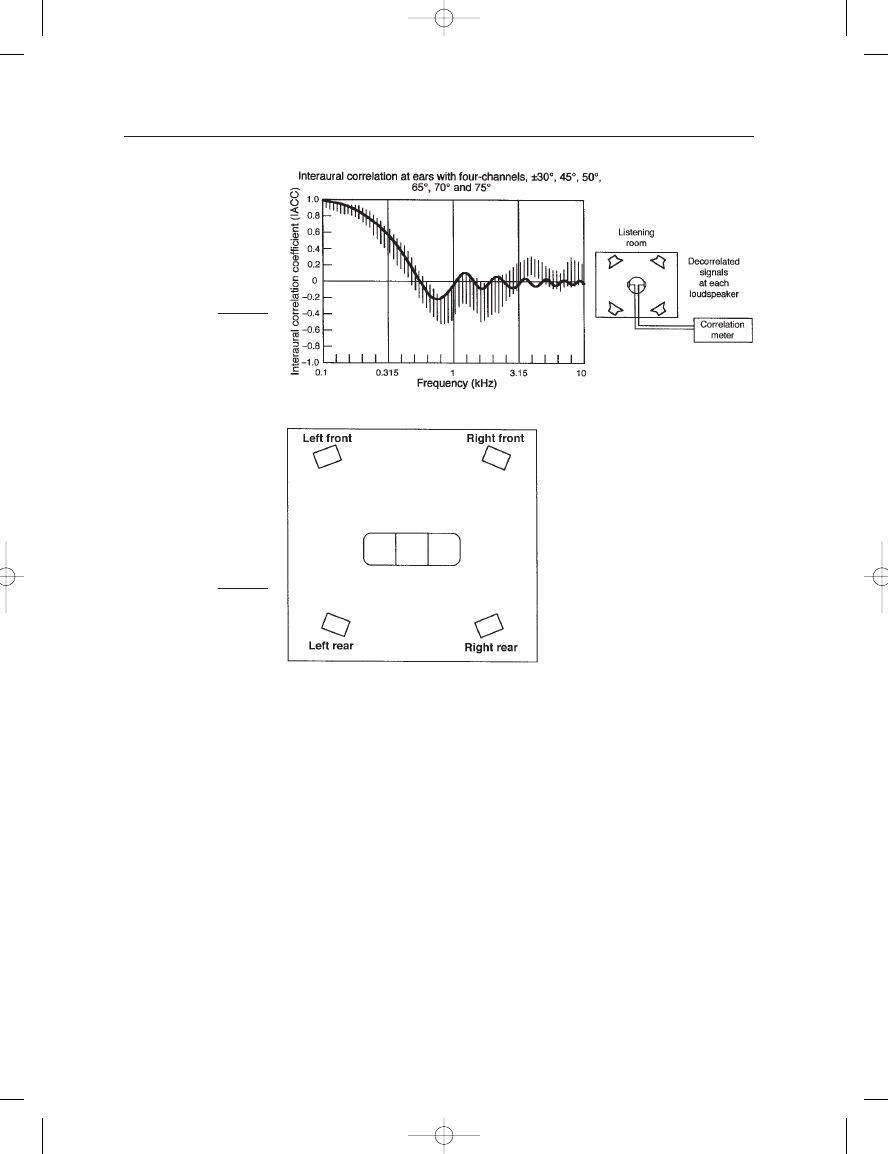ВУЗ: Казахская Национальная Академия Искусств им. Т. Жургенова
Категория: Книга
Дисциплина: Не указана
Добавлен: 03.02.2019
Просмотров: 17283
Скачиваний: 51

C
H
A
P
T
E
R
1
5
SURROUND SOUND
MICROPHONE TECHNOLOGY
INTRODUCTION
While two-channel stereo has been the mainstay of consumer sound
reproduction for nearly a half-century, surround sound as originally
developed for motion pictures has technical roots that go back even
earlier. For the consumer, surround sound as a central requirement in
music-only presentation in the home has had a spotty history.
Quadraphonic (four-channel) sound was introduced in the mid-1970s
and failed, chiefly because the technology proposed for it was not suffi-
ciently developed. During the mid-1990s, surround sound was reintro-
duced to the consumer as an integral part of the home theater revolution,
with its five-channel loudspeaker array consisting of 3 loudspeakers in
front and 2 at the sides slightly to the rear of the listener. The basic plan
was patterned after the normal loudspeaker setup in motion picture
theaters of the day. A primary performance benefit of the “new” video-
based surround sound was the use of a front center channel, which
anchored center-stage events accurately in that position – regardless of
where the listener was located. The added benefit of global ambience as
fleshed out by the back channels was equally beneficial.
The earliest five-channel carriers for music-only surround program-
ming include the DVD Video format (with Dolby AC-3 encoding) and
the DTS (Digital Theater Sound) CD format, both presenting five full-
range channels and a single subwoofer effects channel operating below
100 Hz. (For obvious reasons, the format is known as 5.1 surround
sound.) As the new millennium got under way, two formats, DVD Audio
and Sony/Philips SACD (Super Audio Compact Disc), were both pro-
posed for audio-only applications for surround sound. At the present
time, both these mediums have made a respectable bid for marketplace
acceptance, but neither has been the runaway success that many had
expected.
Earg_15.qxd 14/9/04 2:56 PM Page 243

The first five years of the new century have seen so much develop-
ment in surround technology, including microphone design, microphone
pickup techniques, and playback options, that it will be advantageous to
discuss the technology first in a chapter devoted solely to those topics.
The next chapter will then cover case studies of the various techniques.
For our purposes we will consider four categories of surround sound
recording and playback:
1. Stereo-derived: There are many formats here, and they are basically
derivations of current stereo techniques in that they make use of
both real and phantom images as well as ambient effects that arise
from decorrelated multichannel sources. Quadraphonic and cur-
rent motion picture techniques fall under this category, as do spe-
cial formats such as the TMH Corporation’s 10.2 configuration.
Virtually all of the surround remixes of both legacy and modern
multitrack source tapes fall in this category.
2. Single-point pickup: These techniques are used to sample and play
back a global three-dimensional sound field. The British Soundfield
microphone is an early example here using first-order directional
patterns. The more recent Eigenmike makes use of higher order
patterns. In either cases there is a direct correspondence between
the pickup and playback directions, and the general aim of these
systems is to duplicate natural spatial cues in the playback envi-
ronment. The number of pickup elements is normally limited by the
order of the microphone patterns, but the playback setup can usually
handle more loudspeaker sources than microphones if their drive
signals are properly derived. In all of these systems it is essential
that the listener be positioned at the center, or “sweet spot”, of the
loudspeaker array.
3. Transaural, or head-related, pickup: This spatial sound transmission
technique uses a fairly small number of loudspeakers to duplicate at
the listeners’ ears the exact amplitudes and time relationships that
were physically present in the pickup environment. It is very criti-
cally dependent on loudspeaker–listener positioning, and its major
use is in controlled listening environments (such as those afforded
by computer workstations) where the listener’s head is confined to a
single position.
4. Systems with parallax: Like an acoustical hologram, these systems
allow the listener to move about in the listening space while vir-
tual source locations remain stationary. Generally, a relatively
small number of recorded tracks may be involved, and the real
complexity comes in playback signal processing, where positional
information is superimposed on the various sources via impulse
measurements and signal convolution. The technique is experi-
mental at present, but it holds great promise for use in special
venues.
THE MICROPHONE BOOK
244
Earg_15.qxd 14/9/04 2:56 PM Page 244

For each category summarized above we will describe the general
technical requirements for both recording and optimum playback.
STEREO-DERIVED SYSTEMS
WHAT IS AMBIENCE?
There are three acoustical elements necessary for convincing surround
sound reproduction:
1. Accurate pickup of direct sound originating on-stage; soundstage
imaging should be natural and unambiguous.
2. Pickup of sufficient early reflections from the stage and front por-
tion of the recording space to convey a sense of room size and
dimension. These signals normally fall in the range from 25 to
60 ms after the receipt of direct sound and are generally conveyed
by all of the loudspeakers in the surround array.
3. Pickup of uncorrelated reverberation and its subsequent presenta-
tion over the entire loudspeaker array. The onset of the reverberant
field normally occurs at about 80 ms after the receipt of direct
sound.
Conventional two-channel stereo can deliver the frontal sound-
stage quite accurately for a listener seated directly on-axis, but cues
pertaining to early reflections and reverberation are limited by the
relatively narrow presentation angle in the playback environment. We
need to determine how many channels are actually necessary to do
justice to the demands of surround sound. Tohyama et al. (1995) devel-
oped data showing that a minimum of four channels is necessary to
create an accurate enveloping sound field in the consumer listening
environment. The basis for their study is shown in Figure 15–1. In this
figure, the inset shows an artificial head located in the completely
15: Surround Sound Microphone Technology
245
FIGURE 15–1
Interaural cross-correlation
(IACC) between the ears
of an artificial head
placed in a reverberant
field.
Earg_15.qxd 14/9/04 2:56 PM Page 245

diffuse sound field of a reverberation chamber, which is analogous to
the acoustical field component in a concert hall which conveys the nor-
mal sense of envelopment. The test signal consists of a slowly swept
band of noise ranging from 100 Hz to 10 kHz. The signals reaching the
microphones at the ear positions in the artificial head are compared,
and the mathematical cross-correlation between the ear positions is
measured and shown in the graph. At very low frequencies the correla-
tion is unity, inasmuch as the microphone spacing is small relative to
the received wavelength.
As the signal increases in frequency the cross-correlation converges
to an average of zero, indicating that the received signals at the artificial
head are essentially uncorrelated, a basic condition for conveying a sense
of spatial envelopment at the ears of the listener.
Moving on to Figure 15–2, we now take an uncorrelated two-
channel stereo recording made in the diffuse field of Figure 15–1 and
play it back in a typical living room environment. The artificial head is
again used to pick up the swept signal, and the interaural crosscor-
relation is again measured and plotted, averaging three sets of stereo
loudspeaker playback angles. The graphed data show that the measured
signal correlation at the ears is not uniform, and in fact produces a
significant compromised sense of envelopment, especially at the critical
midrange frequencies between 800 Hz and 3150 Hz. As good as it
sounds, stereo is not capable of generating a convincing sense of spatiality
around the listener.
Figure 15–3 shows similar measurements, this time using four uncor-
related playback channels, averaging them at six different sets of bearing
angles around the measurement system. It is clear that the four-channel
array very nearly produces the same spatial cues as the reference condi-
tion shown in Figure 15–1, indicating that four (or more) channels of
ambience information can successfully produce an accurate enveloping
sound field in the home listening environment. A number of multichan-
nel reverberation systems currently produce such decorrelated sound
fields.
THE MICROPHONE BOOK
246
FIGURE 15–2
IACC for stereo playback
of uncorrelated
reverberation in a typical
listening space.
Earg_15.qxd 14/9/04 2:56 PM Page 246

DETAILS OF THE PLAYBACK SETUP
Figure 15–4 shows for reference purposes a typical quadraphonic play-
back arrangement. While the system could produce a good impression of
recorded ambience, the very wide spacing of the front pair of loud-
speakers (90
) was disturbing to many listeners, primarily because it did
not reproduce front-center phantom images convincingly. Because of
this, many consumers routinely reduced the frontal listening angle to
about 60
, while leaving the back angle in the range of 90.
Surround sound for motion pictures has evolved over the years to the
arrangements shown in Figure 15–5. There are either two surround chan-
nels or three, depending on the vintage of the installation and its imple-
mentation of the Dolby EX-Plus center-rear surround channel. In the
motion picture theater, multiple surround loudspeakers are always used
in order to produce highly uncorrelated signals, the specific source of
which patrons cannot readily identify. This is a very desirable condition
and normally fits the use of the surround channels as carriers of special
environmental, often large-scale, effects in the typical motion picture.
15: Surround Sound Microphone Technology
247
FIGURE 15–3
IACC for quadraphonic
playback of uncorrelated
reverberation in a typical
listening space.
FIGURE 15–4
A typical playback setup for
quadraphonic sound
reproduction in the home
environment.
Earg_15.qxd 14/9/04 2:56 PM Page 247